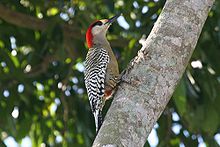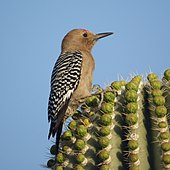Melanerpes
| Melanerpes | ||||||||||
|---|---|---|---|---|---|---|---|---|---|---|
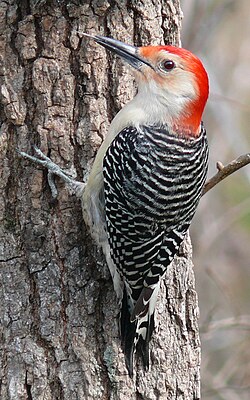
Male Carolinian Woodpecker ( Melanerpes carolinus ) |
||||||||||
| Systematics | ||||||||||
|
||||||||||
| Scientific name | ||||||||||
| Melanerpes | ||||||||||
| Swainson , 1832 |
Melanerpes is a genus of birds from the subfamily Real Woodpeckers within the family of the woodpeckers (Picidae). The mostly brightly colored, tree-dwelling woodpeckers are small to medium-sized. Their distribution area extends from northern North America to central South America, where they occur in different, but mostly rather open, tree-lined landscapes. Some species are endemic to the larger Caribbean islands . Only the populations that live on the northern boundaries of the area are obligatory migratory birds , but some species show unsteady, not very localized behavior and tend tomigrate irregularly . Most species feed on various tree or ground-dwelling insects as well as seeds, fruits and berries, only a few feed predominantly on fruits and other plant-based food components. All are cave breeders who raise their offspring in self-made caves that are built in dead or severely damaged trees, palms or cacti. At least eight species live in sometimes very differentiated social groups; outside of the breeding season, almost all species are found in family groups or in small, occasionally mixed groups. Some, such as the acorn woodpecker , keep their stocks intensively. A distinction is currently made between 24 species, of which the red-headed woodpecker and the Guadeloupe woodpecker are on the IUCN's warning list.
Appearance
The representatives of this species of woodpecker are very variable both in appearance and in size. The smallest species, such as the Yucatán woodpecker , are just 16 centimeters tall, while many species are around 23 centimeters tall, so they are well- sized , and the largest species, the Bahamian woodpecker , is around the same size as the native woodpecker at 32 centimeters Green woodpecker .
All Melanerpes styles are four-toed with zygodactyler toe arrangement.
With regard to the plumage color, two groups of roughly the same size can be distinguished: The representatives of one are conspicuously black and white on the upper side, or, as in the Haiti woodpecker, black and yellow, mostly banded like a ladder, but sometimes also spotted or dotted. Depending on the weighting of the color elements, the upper side appears more light or dark overall. Yellow tones can mainly be found in the shoulder areas. The underside is cream-colored, in the neck and chest areas often yellowish or ocher-colored, it can be largely undrawn or noticeably darkly spotted or banded like spearheads. Brown and pink tones are available in different forms. The face of these woodpeckers is mostly light, the males have a clear, bright red forehead and neck mark and usually a reddish streak of beard . These characteristics are reduced to the neck area in the females or are completely absent. In the support tail, which is usually drawn in black and white on the top, the two central springs are elongated and taper to a point. The very pointed, medium to long poke beak is dark horn-colored, straight or slightly curved downwards at the ridge. Species of this type are represented from southern North America, in Central America, on many Caribbean islands and in South America up to the southern limit of distribution.
The woodpeckers of the second group are much more unevenly colored. What they have in common is that the upper side is largely blackened with no drawings, which also gave the entire genre its name. Some species, such as the red-headed woodpecker with a bright red head, neck, chest and shoulders or the white woodpecker, are very noticeable and unusually colored for woodpeckers. The latter is the only woodpecker species in which the head color of both sexes is largely white and the only Melanerpes species that lacks any red. On the other hand, some species, such as the Guadeloupe woodpecker or the blood-faced woodpecker , have a dark, low-contrast coloration. Overall, black and white contrasts predominate. The black parts of the body, especially the dorsal plumage, can have a slightly green, bluish or purple sheen. Plumage drawings are not available or only very indistinctly. In addition, there are pure red tones in the forehead and crown area, and dark, matt purple tones on the chest and flanks. The color dimorphism is rather weak in some of these woodpeckers, with the red-headed woodpecker and the blood-faced woodpecker the sexes are the same in appearance. Most of the species within this group have a chisel-like beak, which is quite wide at the base, straight or only slightly bent downwards.
Two species, the yellow-brown woodpecker and the cactus woodpecker , are each represented in two color morphs .
Vocalizations
Due to their differences, the vocalizations of the Melanerpes woodpeckers cannot be described together. Information on this can be found in most of the relevant articles. In socially living species, the group members are in constant call contact and are therefore acoustically very noticeable. This applies, for example, to groups of the acorn woodpecker , whose members communicate with loud väka calls. Others, such as the blood-faced woodpecker, behave very calmly. The woodpeckers of this genus seldom drum and rather softly, some apparently not at all.
distribution and habitat

The spread of Melanerpes is limited to the Nearctic and Neotropical . In addition to the continental mainland of North, Central and South America, some species have colonized various Caribbean islands. The blood-faced woodpecker in western North America and the red-headed woodpecker in central and eastern North America penetrate furthest north, while the distribution area of the white woodpecker and cactus woodpecker , which can be found in northern Patagonia, extends farthest south . The greatest biodiversity in a comparatively small area exists with fourteen species in Central America and on various Caribbean islands, on which the Guadeloupe woodpecker, scarlet- breasted woodpecker, Haitian woodpecker, Jamaican woodpecker and Bahamian woodpecker are island endorses. Some Mexican or Central American species, such as the Yucatán woodpecker, the gray-throated woodpecker , the golden-cheeked woodpecker or the Hoffmann woodpecker , only occur in small and increasingly fragmented areas. In northwestern South America, previously known distribution areas of are Buntkopf woodpecker and recently classified as a separate species jewelery woodpecker very small. In contrast, vast areas populate most of the North American and, with the exception of the two above-mentioned, South American species.
The habitats of the individual species are extremely diverse, but landscapes with trees or at least cacti must always be available. Overall, most species show a preference for open landscapes, forest edges, cleared areas or areas with open structures created by fires or storms. The tree species composition of the habitats is very variable and apparently only plays an important role for the few food specialists among the Melanerpes species, such as the acorn woodpecker . This is closely linked to the occurrence of its food trees, different oak species. A sufficient proportion of dead wood within the habitat is an important requirement for many species. Although some species penetrate into dense forest areas, these form the primary habitat for only a few. Melanerpes woodpeckers occur in extremely moist habitats, such as mangrove swamps and alluvial areas, as well as in semi-deserts covered with saguaro or in the thorn bush savannas of the Chaco . Most species are relatively adaptable and can colonize very different habitats within a spatially limited distribution area; this is especially true for the islanders. Many species have got used to the presence of humans and breed in urban areas, in large parks, plantations or in orchards; some Melanerpes species also visit feeding places regularly.
Species of this genus occur from sea level to the regional tree lines. Foraging acorn woodpeckers were found in Colombia at altitudes of 3500 meters.
Food and subsistence
All types of Melanerpes are both herbivorous and carnivorous . The composition and the proportions of plant and animal food vary from species to species as well as within the same species. In general, more animal food is consumed in the pre-breeding season and when the young are raised, and more vegetable food is consumed in autumn and winter. The young, too, are mostly, but not exclusively, provided with animal food. These differences apply above all to the species of the higher northern and southern latitudes, with the tropical species the seasonal differences in food composition are smaller. Most of them can be described as food generalists, the broadest range of food among the melanerpes is probably shown by the red-headed woodpecker and the gila-pecker . On the other hand, the acorn woodpecker and the white woodpecker, which feed on acorns and various fruits, are comparatively specialized. As far as is known, only the gold masked woodpecker is largely herbivorous.
The animal diet consists mainly of insects . Ants , termites , beetles and their wood-dwelling larvae, caterpillars , grasshoppers , crickets and, among the smaller species, aphids predominate here . Flying insects also play a role, the red-headed woodpecker and the blood-faced woodpecker feed primarily on them during the summer months. To a lesser extent, spiders , millipedes , snails , and occasionally small lizards and small mammals are also captured. Bird eggs and nestlings are also more likely to be occasional prey.
The ingested vegetables are just as diverse. Woodpeckers of this genus consume a wide variety of fruits, berries and nuts, seeds, tree saps and nectar. Tree bark can also serve as emergency food. Since some species also visit orchards and corn fields, they are regionally considered pests such as the red-headed woodpecker, the white woodpecker or the Haiti woodpecker, which can cause damage especially in cocoa plantations. In winter, some species visit feeding places where they take in seeds and nuts, but also sugar water.
The food is sought in all trunk and branch sections up to the crown area of high trees. Some species, such as the Gilaspecht or Bloodface Woodpecker, are often seen foraging on the ground, where they exploit anthills, termite mounds or dead wood stumps. However, no species can be described as a pure earth woodpecker; a few species, such as the Jamaican woodpecker, seek and find their food exclusively on trees.
Poking, reading, and probing are the most common food acquisition techniques. Thoroughly hammering the feeding alleys of wood-dwelling larvae only plays a certain role in the larger species. All species seem to occasionally prey on flying insects, with the red-headed woodpecker and the gray-throated woodpecker hunting for swarming insect species plays an essential role. Fruits, seeds and berries are picked directly from the branches, with the woodpeckers often hanging upside down from the branches. Some species process nuts or hard fruits in forges . Above all, but not exclusively, the species living in more northern latitudes usually build storage tanks in coarse-barked trees, but also in telegraph poles or other wooden structures, which are mainly stocked with acorns or corn kernels. This behavior is particularly pronounced in the acorn woodpecker.
behavior
Like all woodpeckers, Melanerpes are also diurnal. They live in pairs or in small family groups, which usually consist of a breeding pair and non-breeding helpers from previous years . The social order of the acorn woodpecker , in which the group size can reach 15 individuals, is particularly differentiated . Some species, such as the yellow-browed woodpecker , can live in single pairs as well as in complex family groups. Outside of the breeding season, species living in pairs are often associated with other species. For them, a largely monogamous seasonal or multi-year relationship seems to be the most common form of partnership. Overall, the social organization with the exception of the acorn woodpecker has not been adequately researched.
All species are territorial at least during the breeding season; those who set up food stores throughout the year. However, mostly only the cave tree and the granary trees are defended against conspecifics and cave competitors, often only the immediate cave area. Overall, the interspecific compatibility and the tendency to form clusters up to differently complex social systems is very pronounced in this genus. The Haitian woodpecker often breeds in colony-like proximity to other species and several pairs of red-headed woodpeckers can occupy nesting holes in a tree. Sleeping societies of up to 26 individuals have been observed in the gray-throated woodpecker , in which up to four adult individuals occasionally sleep in a cave. Nonetheless, fierce group fights have also been observed in socially living species, especially the acorn woodpecker, especially if one partner of the dominant breeding pair dies during the breeding season and another group tries to take over. If this takeover succeeds, the new dominant woodpecker often kills any nestlings that may be present and destroys the clutch.
Breeding biology
All species are cave breeders, who create their caves mainly in the trunk and branch region of dead or dying trees, but occasionally also in vital softwood. The species of the arid and semi-arid areas nest in large cacti , especially in saguaros, some island species in palm trees . In largely treeless areas, various wooden structures such as telegraph poles or building posts are also used as cave supports. The main work of the cave construction is done by the male, the work share of the female varies from species to species and can also be omitted entirely. Like all other woodpeckers, those of the genus Melanerpes do not enter any nesting material, but lay their eggs on the underground of the cave, if necessary on existing wood chips.
The courtship rituals are typical of woodpeckers and consist mainly of calls and drumming, pursuit flights, spiral tree climbing and cave shows.
The clutches consist of 2–5 pure white eggs, in the species living in family groups they are on average larger. Exceptionally large clutches of up to 11 eggs have also been found in the paired blood-faced woodpecker. Woodpeckers from the northern and extreme southern regions breed once a year, but if they lose their eggs early, they spawn a replacement brood. Those of the temperate latitudes and the tropics regularly raise two, occasionally three broods. Both partners brood, always the male at night. The incubation period varies depending on latitude, altitude and clutch size between 11 and 17 days, the nestling time differs from species to species and is between three and five weeks, depending on the food supply and temperature conditions. The length of time the young birds stay in the parent association varies greatly. With some species they migrate widely after the lead time, with those living in family groups they usually stay connected with their parents until the next breeding season or longer, until they establish their own family groups as breeding birds.
In sympatrischem presence of various closely related species hybridizations were observed. They seem to be particularly common in the Hoffmann woodpecker, in which mixed broods with the red cap woodpecker in the north of its range and in the south with the golden-fronted woodpecker were found.
Systematics
The genus Sphyrapicus ( juice lickers ), a genus also restricted to America, forms the sister taxon . The genera Dendropicos , Picoides and Veniliornis are also closely related . The genus Melanerpes currently includes 24 species. M. pulcher ( ornamental woodpecker ) was recently separated from M. chrysauchen ( spotted woodpecker ) as a separate species. On the basis of recent DNA examinations, a separation of M. aurifrons into M. aurifrons (golden-fronted woodpecker) and M. santacruzi (not yet a German name - Velasquez's Woodpecker) is proposed.
| German name | Scientific name | distribution | Hazard level Red List of IUCN |
Remarks | image |
|---|---|---|---|---|---|
| White woodpecker |
Melanerpes candidus ( Otto , 1796) |
Gran Chaco areas south to N- Uruguay , west to the eastern Andean cover |
|
monotypical |

|
| Blood-faced woodpecker |
Melanerpes lewis ( JE Gray , 1849) |
America west of the Rocky Mountains . From British Columbia south to New Mexico . In winter as far as northern Mexico . |
|
monotypical |

|
| Guadeloupe woodpecker |
Melanerpes herminieri ( Lesson , 1830) |
Endemic to Guadeloupe ( Basse-Terre and Grande-Terre ) |
|
monotypical |

|
| Scarlet-breasted woodpecker |
Melanerpes portoricensis ( F. Daudin , 1803) |
Endemic to Puerto Rico - Main Island and Vieques |
|
monotypical |

|
| Red-headed woodpecker |
Melanerpes erythrocephalus ( Linnaeus , 1768) |
East of the Rocky Mountains east to the Atlantic Ocean , south to the Gulf of Mexico |
regionally sharply decreasing stocks |
monotypical - occasionally 2 subspecies |

|
| Acorn woodpecker |
Melanerpes formicivorus ( Swainson , 1827) |
Western USA from Washington via Central America to northern Colombia |
|
2 race groups with a total of 7 subspecies |

|
| Temporal Spotted Woodpecker |
Melanerpes pucherani ( Malherbe , 1849) |
Eastern Central Mexico via Eastern Central America to southern Peru west of the Andes. |
|
monotypically forms a superspecies with M. pulcher and M. chrysauchen |
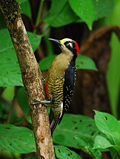
|
| Great spotted woodpecker |
Melanerpes chrysauchen Salvin , 1871 |
Endemic to southwestern Costa Rica and western Panama |
|
monotypically forms a superspecies with M. pucherani and M. pulcher . |

|
| Ornamental woodpecker |
Melanerpes pulcher P. L. Sclater , 1870 |
Colombia (western capping of the Andes) |
|
monotypic - early subspecies of M. chrysauchen forms a superspecies with M. pucherani and M. chrysauchen |

|
| Yellow-browed woodpecker |
Melanerpes cruentatus ( Boddaert , 1783) |
Large areas of northern South America. From the Atlantic coast westwards to the Andes, southwards to NE Bolivia and Mato Grosso |
|
monotypic - 2 color morphs forms a superspecies with M. flavifrons |

|
| Gold masked woodpecker |
Melanerpes flavifrons ( Vieillot , 1818) |
Central and eastern Brazil, eastern Paraguay to northeast Argentina |
|
monotypically (unclear) relatively large variation between northern and southern populations. Forms a superspecies with M. cruentatus . |

|
| Cactus woodpecker |
Melanerpes cactorum ( d'Orbigny , 1840) |
Central South America: from the southeast of Peru to the south of central Argentina. |
|
monotypically 2 morphs |
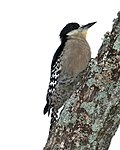
|
| Haitian woodpecker |
Melanerpes striatus ( Statius Müller , 1776) |
Endemic to Hispaniolas |
|
monotypical |
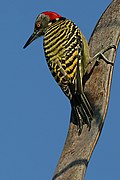
|
| Jamaican woodpecker |
Melanerpes radiolatus ( Wagler , 1827) |
Endemic to Jamaica |
|
monotypical |

|
| Golden-cheeked woodpecker |
Melanerpes chrysogenys ( Vigors , 1839) |
Southwest Mexico |
|
2 subspecies |
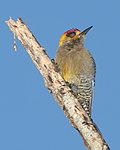
|
| Gray-throated woodpecker |
Melanerpes hypopolius ( Wagler , 1829) |
Endemic to southwest Mexico |
|
monotypical |

|
| Yucatan Woodpecker |
Melanerpes pygmaeus ( Ridgway , 1885) |
Endemic to the Yucatán Peninsula |
|
3 subspecies - forms a superspecies with the red capped woodpecker ( M. rubricapillus ) |

|
| Red-capped woodpecker |
Melanerpes rubricapillus ( Cabanis , 1862) |
Belize south to northern Colombia and east to Suriname |
|
4 subspecies - forms a superspecies with the Yucatán woodpecker ( M. pygmaeus ) |
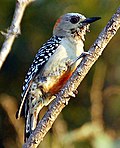
|
| Gilaspecht |
Melanerpes uropygialis ( Baird , 1854) |
Southwestern USA, Western Mexico, Baja California |
|
3 subspecies, according to Winkler et al. 4th |
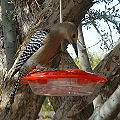
|
| Carolinian Woodpecker |
Melanerpes carolinus ( Linnaeus , 1758) |
Eastern USA, Southeast Canada . West to the eastern foothills of the Rocky Mountains, south to the Gulf Coast |
|
monotypical with some authors up to three subspecies forms a superspecies with M. superciliaris |
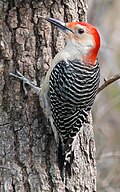
|
| Bahamian Woodpecker |
Melanerpes superciliaris ( Temminck , 1827) |
Cuba and many islands in the northern Caribbean |
|
5 subspecies Forms a superspecies with M. carolinus |

|
| Golden-fronted woodpecker |
Melanerpes aurifrons ( Wagler , 1829) |
Southern Gulf States of the USA, Eastern Mexico, Central America to Nicaragua |
|
monotypically earlier 11 subspecies Forms a superspecies with M. hoffmannii and M. santacruzi New DNA studies show that the species is not monophyletic, so that a split into at least two species M. aurifrons (monotypical) and M. santacruzi ( Bonaparte , 1838) - all other 10 subspecies - is suggested. The IOC's latest list already follows this suggestion. |

|
| No German name established - English: Velasquez's Woodpecker |
Melanerpes santacruzi ( Bonaparte , 1838) |
Central America to Nicaragua |
|
10 subspecies Forms a superspecies with M. hoffmannii and M. aurifrons |

|
| Hoffmann Woodpecker |
Melanerpes hoffmannii ( Cabanis , 1862) |
Pacific side of Central America; from Honduras to Costa Rica |
|
monotypic Forms a superspecies with M. aurifrons |

|
Persistence and Threat
According to the IUCN, 21 of the 24 species are not endangered. Only the Guadeloupe woodpecker and the red-headed woodpecker are on the warning list. For many species, however, insufficient figures are available, so that reliable statements on the population development of most species can hardly be made. Regional studies, however, indicate a decline in the populations of many species, in some cases considerable.
In addition to natural enemies such as various species of martens , raccoons , birds of prey , owls and tree-climbing snakes, rats that have been brought in as nest predators play a particularly diminishing role for the island's endemic species. These, mostly small populations, also react particularly sensitively to interventions in the habitat and hurricane events. The introduced and rapidly spreading European star is a serious cave competitor for some - especially North American - species, and the house sparrow , which has also been introduced, can become a cave competitor for small species. Modern forest management and extensive use of pesticides reduce both the supply of potential cave trees and the food supply. In South America, the greatest danger comes from the transformation of loosened forest areas into almost treeless pastureland. Direct human persecution does not seem to pose a major threat to any species today.
The population development of some species is positively influenced by the application of nesting aids and, especially in the USA, by intensive winter feeding.
literature
- Hans Winkler , David A. Christie, David Nurney: Woodpeckers. A Guide to the Woodpeckers, Piculets, and Wrynecks of the World . Robertsbridge 1995, ISBN 0-395-72043-5 .
Individual evidence
- ↑ Endangerment of the Melanerpes species - overview. Birdlife International pdf engl.
- ↑ Hans Winkler and David A Christie; Woodpeckers (Picidae) In: del Hoyo, J., Elliott, A., Sargatal, J., Christie, DA & de Juana, E. (eds.). Handbook of the Birds of the World Alive. Lynx Edicions, Barcelona 2016 (retrieved from http://www.hbw.com/node/52286 on July 4, 2016).
- ↑ Melanerpes pulcher , data sheet at BirdLife International (pdf engl.)
- ^ Gustavo Kattan: Food habits and social organization of Acorn Woodpeckers in Colombia. In: The Condor. 90, 1988, pp. 100-106.
- ↑ Winkler et al. (1995) p. 199 and p. 213
- ↑ a b Winkler et al. (1995) p. 201
- ↑ Winkler et al. (1995) p. 194
- ↑ Winkler et al. (1995) p. 204
- ↑ Winkler et al. (1995) p. 207
- ↑ Winkler et al. (1995) p. 210
- ^ Walter D. Koenig, Peter B. Stacey, Mark T. Stanback and Ronald L. Mumme: Acorn Woodpecker (Melanerpes formicivorus). In: A. Poole (Ed.): The Birds of North America Online. Cornell Lab of Ornithology, Ithaca 1995. / Behavior
- ↑ Winkler et al. (1995) p. 219
- ↑ Brett W. Benz, Mark B. Robbins, A. Townsend Peterson: Evolutionary history of woodpeckers and allies (Aves: Picidae): Placing key taxa on the phylogenetic tree. In: Molecular Phylogenetics and Evolution 40 (2006): pp. 389-399; P. 394 ff.
- ↑ Split Melanerpes pulcher from M. chrysauchen. ( Memento of the original from June 27, 2010 in the Internet Archive ) Info: The archive link was inserted automatically and has not yet been checked. Please check the original and archive link according to the instructions and then remove this notice. SACC Proposal 123 (2004)
- ↑ Erick A. Garcia-Trejo, Alejandro Espinosa de los Monteros, del Coro Arizmendi Ma. and Adolfo G. Navarro-Sigüenza: Molecular systematics of the Red-Bellied and Golden-Fronted Woodpeckers . In: Condor, 111: 442-452 (2009).
- ↑ Holly H. Edwards and Gary D. Schnell: Gila Woodpecker (Melanerpes uropygialis), The Birds of North America. Online (A. Poole, Ed.), Cornell Lab of Ornithology, Ithaca 2000; from: The Birds of North America. Online, Species 552
- ↑ Winkler et al. (1995) p. 213
- ^ F. Gill & D. Donsker (Eds) 2010: IOC World Bird Names (version 2.5). ( Online , accessed December 7, 2016)
